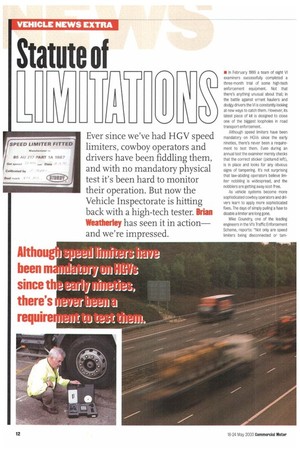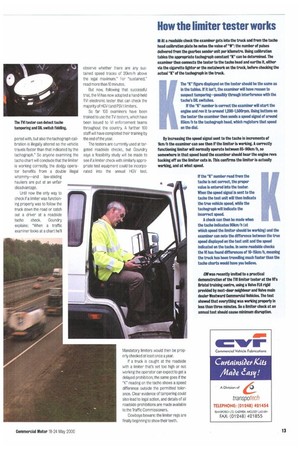Ever since we've had HGV speed limiters, cowboy operators and
Page 14

Page 15

If you've noticed an error in this article please click here to report it so we can fix it.
drivers have been fiddling them, and with no mandatory physical test it's been hard to monitor their operation. But now the Vehicle Inspectorate is hitting back with a high-tech tester. Brian Weatheriey has seen it in action— and we're impressed.
• In February 1999 a team of eight VI examiners successfully completed a three-month trial of some high-tech enforcement equipment. Not that there's anything unusual about that; in the battle against errant hauliers and dodgy drivers the VI is constantly looking at new ways to catch them. However, its latest piece of kit is designed to close one of the biggest loopholes in road transport enforcement.
Although speed limiters have been mandatory on HGVs since the early nineties, there's never been a requirement to test them. Even during an annual test the examiner merely checks that the correct sticker (pictured left), is in place and looks for any obvious signs of tampering. It's not surprising that law-abiding operators believe limiter nobbling is widespread, and the cobblers are getting away scot-free.
As vehicle systems become more sophisticated cowboy operators and drivers learn to apply more sophisticated fixes. The days of simply puling a fuse to disable a limiter are long gone.
Mike Goundry, one of the leading engineers in the VI's Traffic Enforcement Scheme, reports: "Not only are speed limiters being disconnected or tam
pored with, but also the tachograph calibration is illegally altered so the vehicle travels faster than that indicated by the tachograph.' So anyone examining the tacho chart will conclude that the limiter is working correctly, the dodgy operator benefits from a double illegal whammy—and law-abiding hauliers are put at an unfair disadvantage.
Until now the only way to check if a limiter was functioning properly was to follow the truck down the road or catch out a driver at a roadside tacho check. Goundry explains: "When a traffic examiner looks at a chart he'll observe whether there are any sustained speed traces of 20km/h above the legal maximum." For 'sustained," read more than 10 minutes.
But now, following that successful trial, the VI has now adopted a hand-held TVI electronic tester that can check the majority of HGV (and RSV) limiters.
So far 103 examiners have been trained to use the TVI testers, which have been issued to VI enforcement teams throughout the country. A further 100 staff will have completed their training by the end of the year.
The testers are currently used at targeted roadside checks, but Goundry says a feasibility study will be made to see if a limiter check with similarly appropriate test equipment could be incorporated into the annual HGV test.
Mandatory limiters would then be properly checked at least once a year.
If a truck is caught at the roadside with a limiter that's set too high or not working the operator can expect to get a delayed prohibition; the same goes if the "K" reading on the tacho shows a speed difference outside the permitted tolerance. Clear evidence of tampering could also lead to legal action, and details of all roadside prohibitions are made available to the Traffic Commissioners.
Cowboys beware: the limiter regs are finally beginning to show their teeth.








































































































